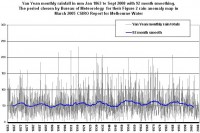By Alan Caruba
We are all so besieged by the drivel that Greens put out daily that it is easy to forget how idiotic it is and, in many cases, how deceitful it is. I recently received an emailed news release with the following headline: “If you don’t know what to buy for the holidays, the Better World Shopping Guide will help you decide.” The Guide is described as “a must-have guide for the socially and environmentally responsible consumer or those who want to improve their awareness.” The guide purports to evaluate 1,000 companies and 75 product categories to determine “a product’s value by price point and its cost to society…” This, my friends, is bull feathers! When you are buying Christmas gifts this year, buy something the recipients will actually enjoy. If you’re in the mall trying to figure out which product threatens all life on Earth, you are certifiably insane.
Slowly, but surely, people are beginning to realize that the environmental movement is not about saving the Earth, but about destroying everything that passes for industry, business, and the enhancement of human life through the use of every kind of energy for transportation and other purposes.
An example of this is a recent editorial in New Scientist magazine titled, “The Folly of Growth: How to stop the economy killing the planet.” Using the “environment” to hide behind, all manner of lies are put forth to justify everything from preposterous schemes such as “cap and trade” of “greenhouse gas emissions”, also sometimes called “pollution credits”, to the claim that we have to scrap the most effective means of generating electricity, coal and nuclear, for wind turbines and solar panels.
The famous line from the movie about the Watergate scandal was “Follow the money.” Who will get rich selling “carbon/pollution credits”? Al Gore and his friends. Who benefits from efforts such as a proposition on the ballot in San Francisco to require that only “clean” energy be used? The owners and investors in wind and solar energy.
The bonus for the Greens is that these and other schemes will impoverish the economy worse than any sub-prime mortgage meltdown. If you have to pay out millions for “carbon credits”, as utilities around the nation are already doing, the person who gets socked with the cost is ultimately to consumer. Making energy expensive is the single most effective way of wrecking the economy.
To achieve this goal, the nation’s environmental organizations are pouring millions into getting Barack Obama elected. The trade publication, Greenwire, has published an article that affirms the findings of Sen. James Inhofe’s (R-OK) investigation into the multi-million dollar funding and partisan political activities of environmental groups. They are non-profits that are not supposed to engage in partisan political activities, but as the article points out, “In every instance, the environmental groups are backing the Democrat.”
Whether it’s what to buy for Christmas, the increased cost of the electricity from your utility or national politics, the Greens are involved via propaganda, bizarre schemes to undermine the nation’s energy needs, or who gets elected. You are being played for a chump while the Greens pick your pockets.
By Jennifer Marohasy, Politics and Environment Blog
In an opinion piece entitled ‘Our hot, dry future’ published by Melbourne’s The Age newspaper on October 6, 2008, Dr David Jones, head of climate analysis at the Australian Bureau of Meteorology, suggested global warming was responsible for the current long drought in Melbourne and that there was worse to come. I don’t think the article was very convincing. I am annoyed that it didn’t include any real data. While Dr Jones claimed that “We know that over the past 11 years Melbourne’s rainfall has been about 20% below the long-term average”, he didn’t explain what period this “long-term average” covers and what is the relevance of the last 11 years given it is accepted that over this period there has been a dominance of El Nino, and therefore dry conditions.
Key Australian Institutions have claimed for some time that we have a water crisis because of climate change.
Indeed in 2005 CSIRO published a “Melbourne Water Climate Change Study” claiming “the greater Melbourne Region has had its lowest rainfall on record compared to all other periods of similar length.” But as blogger, Warwick Hughes, showed some time ago, the period chosen was just 92 months, from October 1996 to May 2004. In order to put their statement in some context Mr Hughes graphed high quality rainfall data for the weather station closest to Melbourne, Yan Yean, back to January 1863 - and he has just updated the chart to the end of September 2008.

See larger image here
The chart indicates that Melbourne experiences dry periods every so often and that the current drought is similar in magnitude to the droughts of 1896, 1925 and 1945. The chart showing 145 years of data, does not support the claim, made by Dr Jones in his article in Melbourne’s The Age, that there has been recent unusual climate change in Melbourne. Indeed periods of drought and flood are a natural hazard. Read more and see links to part I and II here.
By Claudia Rosett, Forbes
It’s not just income taxes that might trash the dreams of Joe the Plumber. Ready or not, Joe and the rest of us are also about to get mugged by the commissars of climate change. On this, I’ve got a bipartisan beef, since both John McCain and Barack Obama have bought into the panicked Al Gore storyline that the earth has a man-made “fever.” Both candidates are promising to meet it with dramatic and costly new forms of government control.
This comes even as Europe, after its fling with the Kyoto treaty, is backing off from grand pledges to cut carbon dioxide emissions, having decided that the whole thing is too expensive. But United Nations Secretary-General Ban Ki-moon calls climate change the “defining issue of our time,” and the U.N. early last year announced that scientific “consensus” had been reached: The climate is in crisis, and it’s man-made. At the U.N. this has morphed into calls for wealthy countries to choke their own productivity and compensate the rest of the world for the weather.
So the plan now is that America, along with its bailouts and other burdens, will sacrifice to the global climate gods. Nevermind that an emissions cap-and-trade bill died in the Senate in June, sunk by the titanic price tag and regulatory overload it would have entailed. America’s top politicians, not entirely averse to finding ever-new ways to control and plunder the electorate, are still chugging the climate-change Kool-Aid. Once this starts, where does it stop? Carbon is the basis of life itself; carbon dioxide is exhaled with every breath. Regulating and taxing such matters is a road map to state meddling in every aspect of daily life.
And is the alarm even justified? U.N. proclamations to the contrary, there are numerous dissenting scientists. Among the dissenters is MIT professor of atmospheric sciences Richard Lindzen. In a recent, richly documented paper, he warns that the huge shift over the past half century toward government funding of scientific research has “led to extreme vulnerability to political manipulation.” He argues that today’s climate “consensus” is much more a product of politics than of science. Big government begets a push toward more of the same. Grants, prizes and jobs go chiefly to those who produce what eco-activists and U.N.-o-crats want to hear.
Who are these folks setting the climate agenda? Most Americans have never heard of Yvo de Boer, and certainly never voted for him. De Boer is a Dutchman, appointed by former Secretary-General Kofi Annan in 2006 to head the U.N. Framework Convention on Climate Change.
De Boer is not a scientist; his bio says he has a “technical degree in social work.” Before joining the UNFCCC in the 1990s, he worked in the Dutch ministry of housing. These days, de Boer jets around the world presiding over conferences--such as last year’s two-week climate summit at a Bali beach resort--aimed at creating a global “climate change regime.” This regime rests on schemes for massive international wealth transfers, with multilateral bureaucracies calculating who owes, who pays and who gets special breaks--while related arms of these proliferating outfits crank out reports in which “science” is invoked to justify the entire set-up.
Among world leaders, there is almost no one left with the courage and vision to challenge any of this. A rare exception is Czech President Vaclav Klaus, who in the 1980s struggled to free his country from Soviet domination and is now sounding the alarm about the growing global tyranny of climate edicts. Last year he published a short book, Blue Planet in Green Shackles. In the subtitle of this book, he asks: “Which is endangered: climate or freedom?” It’s a pity that in America, a country built on free speech and free markets, neither presidential candidate seems willing to take a cue from Klaus. By now, the real question on climate is: Which candidate, once elected, is most likely to back off the campaign promises enough to leave America free to breathe? Read more here.


